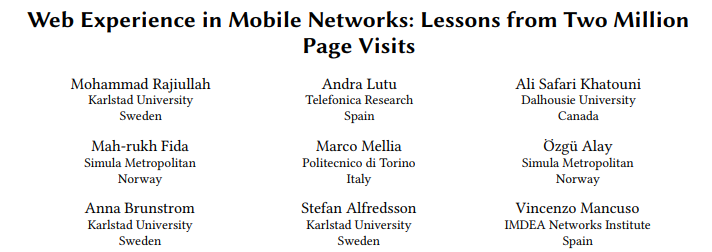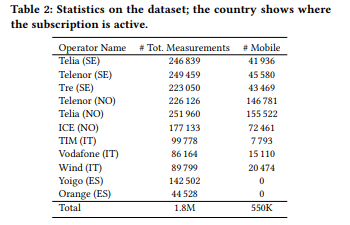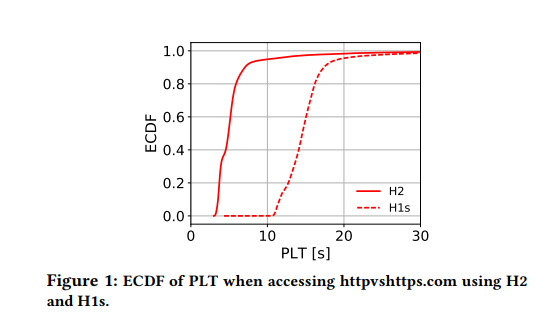Do HTTP/2 or QUIC provide better performance than HTTP/1.1 in mobile networks
The performance of the web protocols has been heavily optimised during the last decades. Given the importance of smartphones and mobile data networks, many web sites try to offer the best performance for mobile users. Many factors can influence the performance of web sites. One of the classical benchmark is the Page Load Time (PLT), i.e. the time required to completely dowload a web page. Many studies has analysed the PLT of web sites and proposed techniques to reduce it in specific scenarios. In a recently published paper, a group of researchers led by Mohammad Rajiullah has analysed a large dataset of measurements performed in mobile networks throughout Europe using the MONROE testbed. They summarise their findings in a paper entitled Web Experience in Mobile Networks: Lessons from Two Million Page Visits that they have recently presented at the Web Conference.

The paper analyses a lot of data and provides many different results. In this blog post, I will not anlyse it in details. However, I’d like to point out a few interesting results considering HTTP/1.1, HTTP/2.0 and QUIC. HTTP/1.1 is the standard version of HTTP today. It is being slowly replaced by HTTP/2.0 that still runs above TCP. HTTP/2.0 brings several interesting features such as the utilisation of a binary format instead of ASCII headers, the ability to stream different objects over the same TCP connection or the possibility for the server to push objects that have not yet been requested by the clients. QUIC goes one step further by replacing TCP with an optimised transport that also supports multiple streams, include the security features of TLS and runs above UDP. Both HTTP/2.0 and QUIC are supposed to improve the PLT of web sites. The study reported in Web Experience in Mobile Networks: Lessons from Two Million Page Visits considers very different mobile networks

The first dataset that they analyse is the PLT when accessing the httpvshttps.com website which was designed to demonstrate the benefits of HTTP/2.0. The result clearly show that on this website, HTTP/2.0 improves the PLT. However, this website is not a regular website, it was designed to demonstrate this result.

They then consider standard websites shown in the table below.

The results obtained with Firefox and Chrome are much less clear on the difference in performance between HTTP/1.1 and HTTP/2.0.

As the authors note later, “The benefit for H2 is very limited or absent in our tests. One reason that has been identified could be that some of the key H2 features are still not in use at large in the server side.”.
They also compare HTTP/2.0 and QUIC over the websites that already support it. Again, they do not see a strong difference between the two protocols: “We observe even less benefits for using QUIC instead of H2. Our detailed analysis of QUIC traces show that some objects from the QUIC compatible sites are still not transported using the QUIC protocol, which we believe a hurdle to put QUIC and H2/H1s in a common performance scale. Again, many factors also influence and bring variability into mobile Web browsing performance, overshadowing the impact of the protocols and leading to mixed performance results.”
This paper shows that optimising the performance of web protocols remains difficult and that a simple benchmark is not always sufficient to completely evaluate the performance impact of a given modification. I encourage you to read the comple paper for more details.
Mohammad Rajiullah, Andra Lutu, Ali Safari Khatouni, Mah-rukh Fida, Marco Mellia, Özgü Alay, Anna Brunstrom, Stefan Alfredsson, and Vincenzo Mancuso. 2019. Web Experience in Mobile Networks: Lessons from Two Million Page Visits. In Proceedings of the 2019 World Wide Web Conference (WWW ’19), May 13–17, 2019, San Francisco, CA, USA. ACM, New York, NY, USA, 12 pages. https://doi.org/10.1145/3308558.3313606
This blog post was written to inform the readers of Computer Networking : Principles, Protocols and Practice about the evolution of the field. You can subscribe to the Atom feed for this blog at https://obonaventure.github.io/cnp3blog/feed.xml. These notes are also posted on the ebook’s Facebook page
